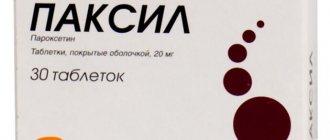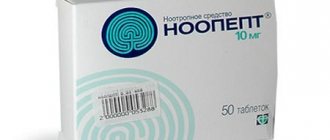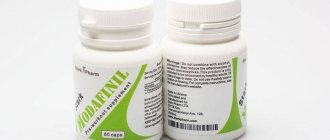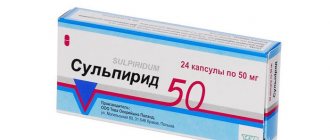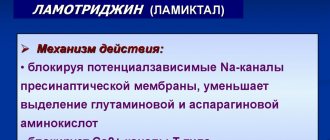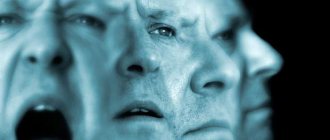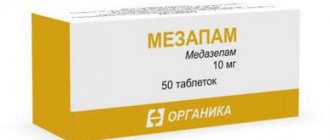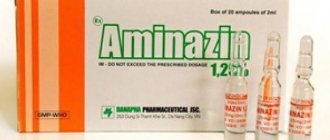| This article violates the rule against instructions in encyclopedia articles. Its text almost completely repeats the instructions for use of the drug provided by its manufacturer. In addition, the data provided may not be sufficiently objective and reliable (especially regarding the effectiveness and safety of the drug). To maintain neutrality of presentation, it is necessary to rework this article based on independent authoritative sources of information. |
| Doxepin | |
| Doxepin | |
| Chemical compound | |
| Gross formula | C₁₉H₂₁NO |
| Molar mass | 279,376 |
| CAS | 1668-19-5 |
| PubChem | 3158 |
| DrugBank | DB01142 |
| Classification | |
| Pharmacol. group | Antidepressants |
| ATX | N06AA12 |
Doxepin
(Doxepine) is a white crystalline powder. It is highly soluble in water, less soluble in alcohol and chloroform.
Antidepressant with anxiolytic and sedative properties. It has antiserotonin, anticholinergic, antihistamine, and antiulcer effects.
Quickly and completely absorbed into the gastrointestinal tract, T1/2 is 28-52 hours; undergoes biotransformation in the liver to form the active metabolite of dimethyldoxepine and is excreted by the kidneys.
Action and effect of doxepin
The drug must be taken orally. One of the principles of action of the drug is based on metabolization in the liver through the formation of the main metabolite - dimethyldoxepine. Doxepin is well absorbed from the gastrointestinal tract and excreted in the urine in the form of metabolites. Also increases the amount of monoamines in the CNS (central nervous system), especially serotonin; increases the concentration of norepinephrine in synapses. The drug has adrenergic blocking, antihistamine and anticholinergic effects. The effect of the medication begins to take effect 2-3 weeks after the start of treatment.
Interaction
Enhances the effect of levodopa and atropine. Increases the toxicity of morphine, barbiturates, pethidine. Concomitant use with lithium increases the risk of pernicious neurotic syndrome. When prescribed with antipsychotics, it is necessary to reduce the dose by 50%. Ethanol enhances the sedative effect.
Do not use with MAO inhibitors (they should be discontinued 2-3 weeks before prescribing this drug), chlorpromazine, sulfopride, quinidine. Use caution when using concomitantly with digitalis and baclofen.
Doxepin with prescription or not
The use of an antidepressant must be agreed with the attending physician. It is not possible to buy Doxepin without a prescription. Without a doctor's prescription, you can only purchase drugs for the treatment of mild depressive disorders. Thus, doxepin can be purchased at a pharmacy only with a doctor's prescription.
Self-administration of doxepin can lead to an overdose, which can lead to serotonin intoxication in the body. Intoxication when using the drug can be fatal.
Analogues of the drug
The cost of antidepressants varies greatly. Doxepin has analogues, the price of which varies from approximately 25 to 6,000 rubles.
The prescription of doxepin and antidepressant analogues will be carried out by a neurologist or psychotherapist after a thorough examination of the body. However, St. John's wort antidepressants can be purchased without a prescription. Examples of preparations based on this plant:
- Negrustin;
- Neuroplant;
- Life 900;
- Deprim;
- Gelarium Hypericum.
Doxepin side effects
Side effects of the sedative drug doxepin are expressed as:
- headache;
- nausea and vomiting;
- drowsiness;
- dizziness;
- tinnitus;
- hallucinations;
- constipation;
- ulcers on the oral mucosa;
- taste changes;
- diarrhea;
- disorders of the endocrine system.
Most side effects when using the drug appear only at the beginning of use.
Overdose
In case of overdose, the following side effects may develop: dilated pupils, drowsiness, dry mouth, hallucinations, nausea, blurred vision, arrhythmias, tachycardia, severe arterial hypotension, respiratory depression, stupor, changes in the electrocardiogram (especially QRS) characteristic of intoxication with tricyclic antidepressants. , muscle rigidity, convulsions, coma.
To treat the condition, gastric lavage, ventilation of the lungs, and correction of the function of the cardiovascular system should be performed. If necessary, administer physostigmine. Hemodialysis is ineffective.
Contraindications for use
The drug is contraindicated for use in:
- hypersensitivity to it;
- diseases of the cardiovascular system;
- pregnancy and lactation (breastfeeding period);
- renal dysfunction;
- manic-depressive psychosis;
- adenoma (benign tumor) of the prostate gland;
- left bundle branch block;
- under 12 years of age;
- glaucoma.
The simultaneous consumption of alcoholic beverages along with an antidepressant is prohibited. It is not recommended to take the drug together with irreversible MAO inhibitors, lithium, reserpine, or with urinary retention. You should also not take MAO for two weeks before using doxepin.
Doxepin - instructions for use, analogues, composition, indications
About the drug:
Doxepin belongs to the group of tricyclic antidepressants, derivatives of dibenzoxepin.
Indications and dosage:
- Depression (as a manifestation of manic-depressive psychosis and also with cognitive impairment)
- Anxiety against the background of neuroses, neurosis-like conditions, psychoses, chronic alcohol dependence, organic damage to the central nervous system; – panic disorders
- Neurotic reactions with persistent, pronounced vegetative reactions and sleep disturbances
- Premedication before minimally invasive procedures that do not require general anesthesia (for example, before endoscopic examinations)
- In complex therapy of peptic ulcer, premenstrual syndrome, various chronic pain syndromes, especially with neuropathies
- Prevention of migraine, itchy skin
Taken orally immediately after meals (irritates the gastric mucosa), with a small amount of water up to 2 times a day. The initial daily dose for moderate clinical manifestations is 75 mg, with subsequent possible increase by titration to 150 or up to 300 mg per day for severe symptoms of depression. For minimal depressive and anxiety disorders, the daily dose is reduced to 25-50 mg. The duration of the course is on average 2-3 weeks with a gradual reduction in the dose until complete withdrawal. To prepare for endoscopic and other minimally invasive examinations, the drug is administered intramuscularly in a single dose of 25-50 mg, depending on the patient’s weight and the volume of the examination, half an hour to an hour before the examination.
Overdose:
In case of an overdose of Doxipin, side effects occur in extreme forms: lethargy, coma, ataxia, hallucinations, psychomotor agitation, increased reflexes, muscle rigidity, epileptic seizures. Hemodynamic instability, rhythm and conduction disturbances, cardiogenic, arrhythmogenic shock, respiratory depression, shortness of breath, dyspepsia, decreased urine output up to anuria. If an overdose of Doxipin is suspected, hospitalization is necessary. When taking the drug orally, gastric lavage and administration of adsorbents; for severe anticholinergic effects - administration of cholinesterase inhibitors, maintenance of hemodynamics and water-electrolyte balance, anticonvulsant therapy, mechanical ventilation and other resuscitation and intensive measures. Dialysis methods and forced diuresis in case of Doxipine overdose are ineffective.
Side effects:
- Side effects are associated mainly with the anticholinergic effect: visual impairment, increased intraocular pressure with predisposition, impaired bipolar vision, increased heart rate, arrhythmias, varying degrees of intraventricular blockade, decreased peripheral pressure, dry oral mucosa, stomatitis, dyspepsia, constipation, even to hypokinetic intestinal obstruction, urinary retention, dry skin and mucous membranes.
- Impaired consciousness in the form of confusion, mnestic and cognitive impairment.
- Also, taking the drug in some cases can worsen depressive symptoms, psychotic disorders, and lead to the appearance of productive hallucinatory symptoms and delirious states.
- Paresthesia, myasthenia, increased frequency of epileptic episodes.
- Hematopoiesis disorders: eosinophilia, cytopenia, hemorrhagic vasculitis.
- Endocrine system disorders – testicular swelling, gynecomastia; increase in the size of the mammary glands, galactorrhea; decreased or increased libido, decreased potency, electrolyte disturbances, impaired carbohydrate metabolism, impaired liver and kidney function.
- Allergic reactions: urticaria, angioedema.
Contraindications:
- Absolute: individual intolerance, taking MAO inhibitors 2 weeks before the start of treatment, intoxication of various origins, closed-angle glaucoma, rhythm and conduction disorders, children under 12 years of age, acute period of myocardial infarction.
- Relative contraindications are: chronic exogenous intoxication (in particular ethanol), bronchial asthma, manic-depressive psychosis, cytopenia, pregnancy (especially the first trimester), breastfeeding (since the drug passes into breast milk and can cause depression of the nervous system in children), severe diseases of the cardiovascular system, cerebrovascular accident, impaired motor function of the gastrointestinal tract, increased intraocular pressure, liver and/or renal failure, thyrotoxicosis, prostatic hyperplasia, schizophrenia, epilepsy, with caution in old age.
Interaction with other drugs and alcohol:
It is extremely necessary to use Doxipin with drugs that depress the central nervous system, anticholinergics, anticoagulants, thyroid hormones, and hematotoxic drugs due to the summation of effects and increased toxicity. Reduces the effectiveness of phenytoin and alpha-blockers. Cimetidine increases the risk of developing the toxic effects of doxepin. When taken simultaneously with barbiturates, oral contraceptives, or nicotine, the concentration of Doxipine decreases and an increase in dose may be required. Fluoxetine and fluvoxamine increase plasma concentrations. Concomitant use of antiarrhythmic drugs, especially quinidine derivatives, may increase intraventricular conduction disturbances. Incompatible with MAO inhibitors. Combined use with nasal and intraocular alpha-agonists enhances their vasoconstrictor effect. M-anticholinergics, antipsychotics together with Doxipine increase the risk of developing thermoregulation disorders.
Composition and properties:
Doxepin hydrochloride 10, 25, 50, 75 mg.
Release form:
Available in the form of capsules of 10, 25, 50 and 75 mg, solution for intramuscular injection (ampoules) of 25, 50 mg - 2 ml.
Pharmachologic effect:
It has a complex effect - mainly antidepressant, antipanic (anxiolytic), central analgesic, moderate antiulcer, antipruritic. Due to its high affinity for m-cholinergic receptors, it has a central and peripheral anticholinergic effect; has sedative and alpha-adrenergic blocking effects, slows down intraventricular conduction in medium doses, and if the dosage is exceeded, it can cause severe rhythm and conduction disturbances, and in extreme cases, cardiac arrest. Early anxiolytic and later antidepressant effects are realized due to the accumulation of serotonin and norepinephrine in the central nervous system and synapses, due to the disruption of their reabsorption as a result of inhibition of neuronal reuptake. Long-term use normalizes adrenergic and serotonergic transmission, which are disrupted in depressive states. Improves mood, eliminates apathy, reduces anxiety, panic and depressive symptoms. Effective for bulemic disorders, both accompanied by depression and without it. Reduces vegetative manifestations in neurotic disorders. Anticholinergic, sedative effects and blockade of H2 histamine receptors cause an antiulcer effect. Anticholinergic activity can explain the use of the drug for bedwetting. The central analgesic effect is also associated with the accumulation of serotonin and the effect on the endogenous opioid system. Pharmacokinetics. After oral administration, it is quickly and completely absorbed. Almost completely (90%) binds to blood plasma proteins. It is excreted by the kidneys in an altered state in the form of metabolites.
Storage conditions:
In a dark, dry place at room temperature.
general information
- Form of sale:
by prescription - Current issue:
Doxepin
- Manufacturer:
Piluli
- Pharm. group:
Tricyclic antidepressants
ATX code
- N
Drugs for the treatment of diseases of the nervous system
- N06
Psychoanaleptics
- N06A
Antidepressants
- N06AA
Monoamine reuptake inhibitors, non-selective
- N06AA12
Doxepin

